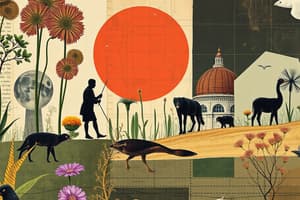Podcast
Questions and Answers
What does a high Diversity Index indicate about an ecosystem?
What does a high Diversity Index indicate about an ecosystem?
Genetic diversity refers to the variety of species present in an ecosystem.
Genetic diversity refers to the variety of species present in an ecosystem.
False
What is the primary purpose of remote sensing in biodiversity studies?
What is the primary purpose of remote sensing in biodiversity studies?
To analyze pictures from satellites to scan large areas
In the binomial nomenclature system, the first word represents the ______ of the species.
In the binomial nomenclature system, the first word represents the ______ of the species.
Signup and view all the answers
Match the kingdoms to their characteristics:
Match the kingdoms to their characteristics:
Signup and view all the answers
What type of organisms does the Monera kingdom primarily consist of?
What type of organisms does the Monera kingdom primarily consist of?
Signup and view all the answers
Tundra biomes have high precipitation and high biodiversity.
Tundra biomes have high precipitation and high biodiversity.
Signup and view all the answers
What is coevolution?
What is coevolution?
Signup and view all the answers
The _______ biome is characterized by low rainfall and special adaptations in organisms.
The _______ biome is characterized by low rainfall and special adaptations in organisms.
Signup and view all the answers
Match the following biomes with their characteristics:
Match the following biomes with their characteristics:
Signup and view all the answers
Which biome is known for having the greatest biodiversity?
Which biome is known for having the greatest biodiversity?
Signup and view all the answers
What role do producers play in an ecosystem?
What role do producers play in an ecosystem?
Signup and view all the answers
Which type of consumer primarily eats producers?
Which type of consumer primarily eats producers?
Signup and view all the answers
Tertiary consumers are apex predators and do not decompose.
Tertiary consumers are apex predators and do not decompose.
Signup and view all the answers
What is the process of breaking down nutrients in waste and dead matter called?
What is the process of breaking down nutrients in waste and dead matter called?
Signup and view all the answers
In a food web, _______ consumers eat secondary consumers.
In a food web, _______ consumers eat secondary consumers.
Signup and view all the answers
Match each term with its description:
Match each term with its description:
Signup and view all the answers
What is the typical energy transfer efficiency from one trophic level to the next?
What is the typical energy transfer efficiency from one trophic level to the next?
Signup and view all the answers
A pyramid of biomass can only be normal and cannot be inverted.
A pyramid of biomass can only be normal and cannot be inverted.
Signup and view all the answers
Define detritivores.
Define detritivores.
Signup and view all the answers
In a normal pyramid of numbers, there are many small ______ at each trophic level.
In a normal pyramid of numbers, there are many small ______ at each trophic level.
Signup and view all the answers
Which relationship is exemplified by flowers and bees?
Which relationship is exemplified by flowers and bees?
Signup and view all the answers
Which of the following is an example of a structural adaptation?
Which of the following is an example of a structural adaptation?
Signup and view all the answers
Natural selection can lead to the creation of new species over time.
Natural selection can lead to the creation of new species over time.
Signup and view all the answers
What is the primary purpose of adaptations in organisms?
What is the primary purpose of adaptations in organisms?
Signup and view all the answers
The theory of evolution is based on the concept of ______ - producing more offspring than can survive.
The theory of evolution is based on the concept of ______ - producing more offspring than can survive.
Signup and view all the answers
Match the organisms with their adaptive changes:
Match the organisms with their adaptive changes:
Signup and view all the answers
Which statement best explains fitness in biological terms?
Which statement best explains fitness in biological terms?
Signup and view all the answers
All organisms in a species must have identical traits for them to be considered the same species.
All organisms in a species must have identical traits for them to be considered the same species.
Signup and view all the answers
What are the four main purposes of adaptations in organisms?
What are the four main purposes of adaptations in organisms?
Signup and view all the answers
The term ______ refers to cumulative inherited changes in organisms over time.
The term ______ refers to cumulative inherited changes in organisms over time.
Signup and view all the answers
Study Notes
Unit 1.1 Ecosystems, Species, and Genetic Diversity
- Species are groups of organisms with similar structure, capable of reproducing fertile offspring.
- All living things are made up of cells, and have needs like energy, growth, development, and reproduction. Organisms adapt to their environment.
- Biological diversity, or biodiversity, refers to the variety of species and ecosystems.
- Remote sensing is used to analyze pictures from satellites to assess large areas for biodiversity.
- Diversity indices measure biodiversity by comparing the number of species to the total organisms in an area. High diversity indicates a healthier ecosystem.
- Biodiversity has three main components: ecosystem diversity (different environments), community diversity (variety within ecosystems), and species diversity (variety within a species). Genetic diversity is the variation within an organism at the cellular level, such as different blood types.
- Biotic refers to living things, while abiotic refers to non-living things.
- Ecosystems are areas where biotic and abiotic factors interact, constantly changing. Habitats are where species live.
- Populations are members of the same species in the same area, sharing resources, and exhibiting variations in traits.
- Communities involve different populations interacting in a shared space. Species distribution varies, with greatest diversity in tropical rainforests and less diversity closer to the poles.
- Taxonomy classifies species into natural groups.
The 5 Kingdoms
- The five kingdoms are: Animalia (multicellular, depend on other organisms for food), Plantae (multicellular, produce food through photosynthesis), Fungi (uni/multicellular, absorbing food from other organisms), Protista (mostly unicellular organisms), and Monera (unicellular organisms lacking a membrane-bound nucleus).
Biomes
- Significant biomes are aquatic (fresh/saltwater), grasslands (dominated by grass), forests (dominated by trees), deserts (low precipitation, low diversity), and tundra (cold, inhospitable).
Interdependence
- Each species depends on others for survival within its ecosystem. Coevolution refers to the evolutionary relationship between interacting species.
Food Chains and Food Webs
- A food chain shows how energy flows from producers to consumers in an ecosystem, whereas a food web represents the complex interactions in an ecosystem, including multiple interconnected food chains.
- Producers (autotrophs) make their own food, consumers (heterotrophs) eat other organisms, and decomposers break down dead materials. Trophic levels indicate different feeding relationships.
- The pyramid of energy shows that only about 10% of energy is transferred from one trophic level to the next. The pyramid of biomass shows the total mass of organisms at each trophic level. The pyramid of numbers shows the number of organisms at each trophic level. Variations can occur between organism populations during these trophic level processes.
- Time delays between predator and prey populations can occur in response to the consumption at different levels.
- Symbiosis describes close relationships among different species. Types include commensalism (+/0), mutualism (+/+), and parasitism (+/-).
Variation within Species
- Variability is the variation within a species, leading to diverse traits and characteristics.
- Sexual dimorphism refers to differences between male and female of the same species.
- Polymorphism is the occurrence of multiple forms (variations) within a single species.
- Metamorphosis refers to a dramatic change in form during the life cycle of some organisms.
- Seasonal adaptations lead to changes in external appearance depending on environmental factors (seasons), while birth anomalies are unexpected traits in offspring.
Healthy Living
- Health choices affect living standards since poor choices can lead to various diseases and malnutrition. Environmental and lifestyle factors influence living standards, and organisms adapt and evolve to be successful in their environment.
Theory of Evolution
- Organisms reproduce more offspring than can survive; there is competition for limited resources, with variation among individuals, selecting for successful variations.
- Survivors reproduce more successfully, and these adaptations lead to speciation (formation of new species).
Microevolution and Evidence of Evolution
- Microevolution refers to changes in gene frequency within a population over time. Evidence includes fossils, biogeography (geographic distribution of organisms), comparative anatomy (comparing body structures), comparative embryology (comparative development during the embryonic stage), and biochemistry (comparing molecules, like DNA).
Unit 2.1 Variations
- Inherited characteristics are traits passed from generation to generation.
- Heritable traits are traits coded by the genetic material within an organism, which is shared between parent to offspring. Non-heritable characteristics are not passed on from generation to generation.
- Discrete variation typically shows either-or outcomes (e.g., blood types). Continuous variation shows a continuum of traits. Variations in characteristics can be influenced by both genes and the environment.
Unit 2.2 Variations
- Characteristics are inherited from parents, influencing the traits of organisms.
- Variation (differences) exists within and among species, and differences are influenced by both genes and the environment.
Asexual and Sexual Reproduction
- Asexual reproduction involves one parent, producing identical offspring (clones), whereas sexual reproduction involves two parents, producing varied offspring.
- Different methods of asexual reproduction include binary fission, budding, vegetative reproduction, and spore production, while sexual reproduction involves the union of gametes (sex cells) to form a zygote.
- Sexual reproduction requires two organisms to participate, resulting in offspring with unique combinations of genetic material from both parents. This process increases diversity among offspring.
Fertilization
- Fertilization is the union of male and female gametes (sex cells) to form a zygote.
- Internal fertilization occurs inside the female body, and external fertilization occurs outside the female body.
- Different plant species use different mechanisms to transfer pollen to accomplish fertilization (cross-pollination, self-pollination) resulting in the formation of seeds, and offspring growth processes.
Cross-Fertilization
- Many plants can self-pollinate, whereas other plants produce separate male and female gametes.
- Cross-pollination involves pollen from one plant transferring to the stigma of another plant.
Variation, Nature, and Nurture
- Nature and nurture work together, nature being the genetic instructions, and nurture being the environmental factors that influence a species' survival, affecting developmental processes, impacting how traits present.
Unit 3.1 DNA, Unit 3.2 Cell Division
- DNA (deoxyribonucleic acid) is the blueprint for making copies of somatic cells, holding the genetic information, and responsible for variations, traits, and adaptations within organisms. This nucleic acid is a polymer composed of nucleotides (adenine, thymine, guanine, cytosine), and pairs with each other by creating hydrogen bonds (a-t, g-c).
- Cell division results from processes such as mitosis and meiosis, these processes are vital for organism growth, repair, and reproduction, by cloning either the organism or producing offspring with unique variations via DNA recombination.
- Mutations and mutagens can result from errors during DNA replication, causing changes in genes.
Mitosis
- Mitosis is a type of cell division that results in two identical daughter cells, essential for growth and repair.
Meiosis
- Meiosis is a type of cell division that produces four unique daughter cells, crucial for sexual reproduction. These daughter cells exhibit unique combinations of genetic material as a result of gene recombination from both parents, increasing genetic diversity.
Studying That Suits You
Use AI to generate personalized quizzes and flashcards to suit your learning preferences.
Related Documents
Description
Test your knowledge on biodiversity and ecosystems with this comprehensive quiz. Explore topics such as diversity indices, genetic variation, biomes, and the roles of different organisms within ecosystems. Ideal for students studying environmental science or ecology.




